2017 FIAT 500L LIVING bonnet
[x] Cancel search: bonnetPage 6 of 240
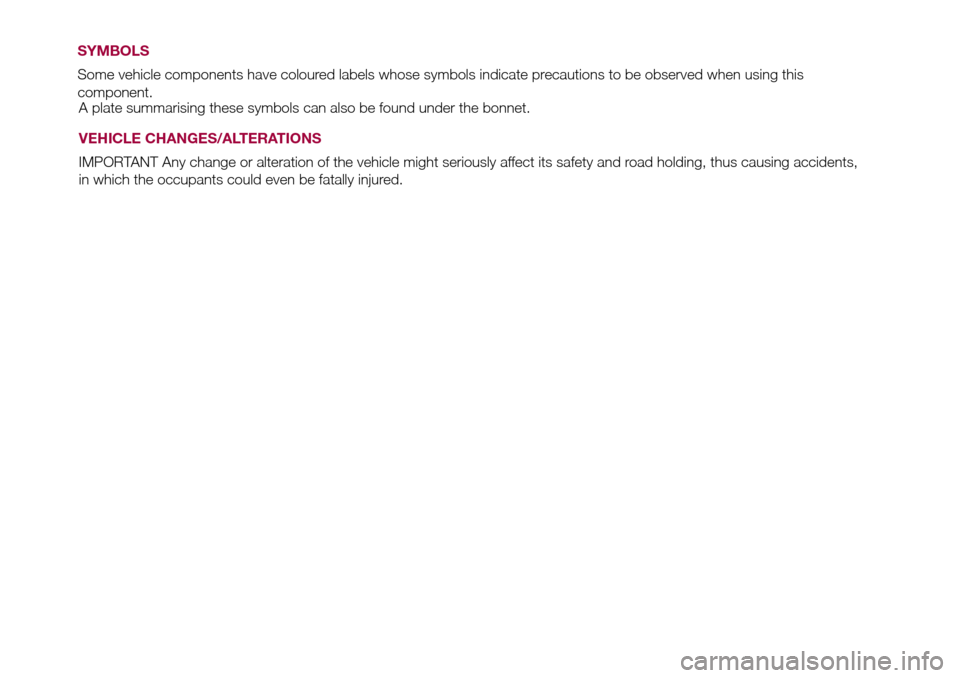
A plate summarising these symbols can also be found under the bonnet.
VEHICLE CHANGES/ALTERATIONS
IMPORTANT Any change or alteration of the vehicle might seriously affect its safety and road holding, thus causing accidents,
in which the occupants could even be fatally injured.
SYMBOLS
Some vehicle components have coloured labels whose symbols indicate precautions to be observed when using this
component.
Page 8 of 240
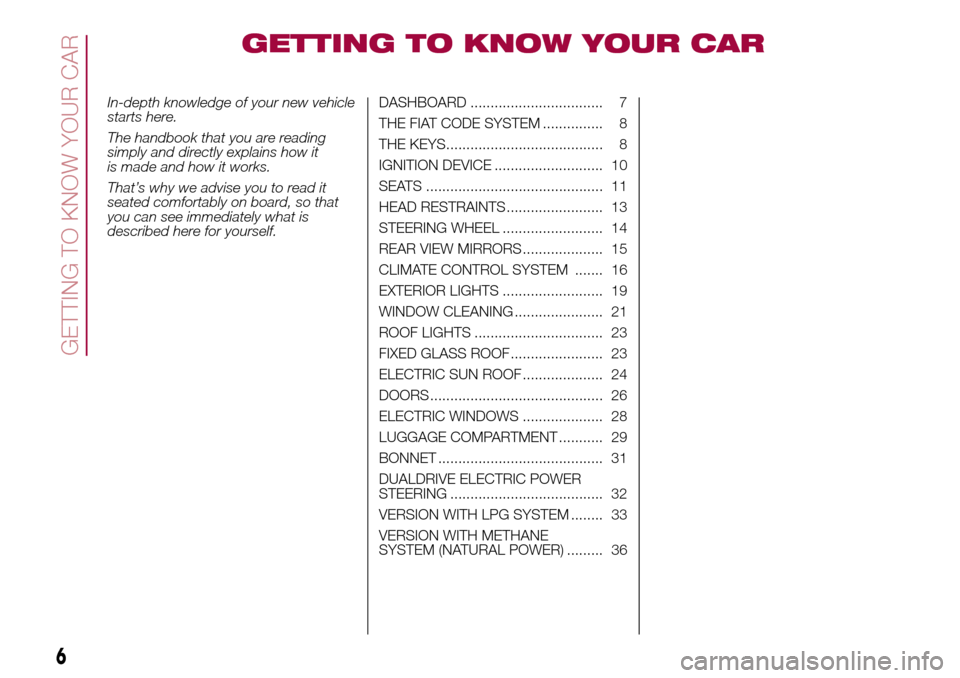
GETTING TO KNOW YOUR CAR
In-depth knowledge of your new vehicle
starts here.
The handbook that you are reading
simply and directly explains how it
is made and how it works.
That’s why we advise you to read it
seated comfortably on board, so that
you can see immediately what is
described here for yourself.DASHBOARD ................................. 7
THE FIAT CODE SYSTEM ............... 8
THE KEYS....................................... 8
IGNITION DEVICE ........................... 10
SEATS ............................................ 11
HEAD RESTRAINTS ........................ 13
STEERING WHEEL ......................... 14
REAR VIEW MIRRORS .................... 15
CLIMATE CONTROL SYSTEM ....... 16
EXTERIOR LIGHTS ......................... 19
WINDOW CLEANING ...................... 21
ROOF LIGHTS ................................ 23
FIXED GLASS ROOF ....................... 23
ELECTRIC SUN ROOF .................... 24
DOORS ........................................... 26
ELECTRIC WINDOWS .................... 28
LUGGAGE COMPARTMENT ........... 29
BONNET ......................................... 31
DUALDRIVE ELECTRIC POWER
STEERING ...................................... 32
VERSION WITH LPG SYSTEM ........ 33
VERSION WITH METHANE
SYSTEM (NATURAL POWER) ......... 36
6
GETTING TO KNOW YOUR CAR
Page 33 of 240
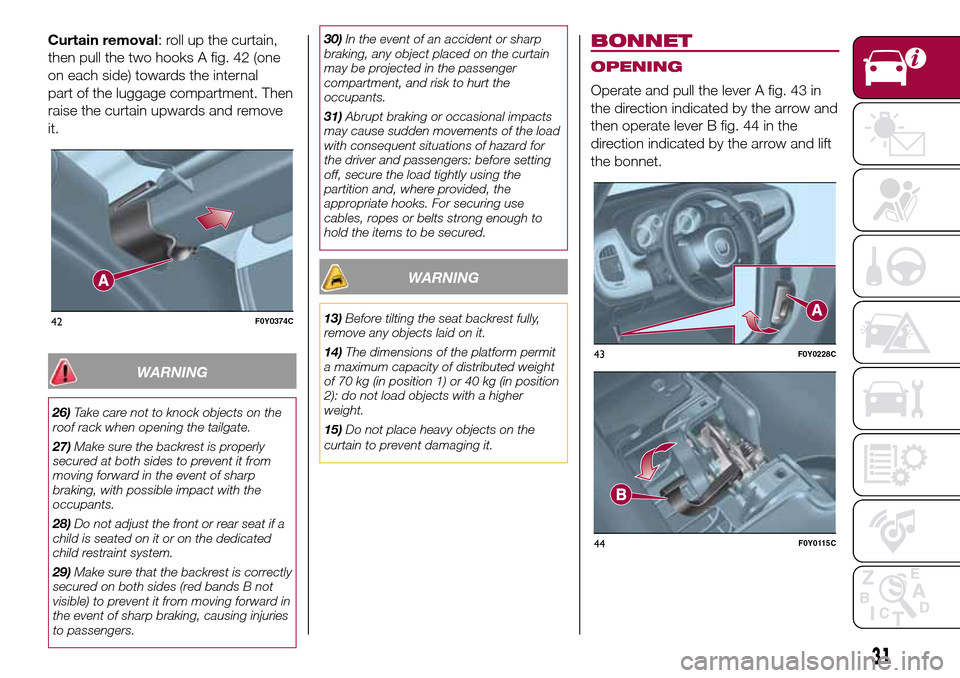
Curtain removal: roll up the curtain,
then pull the two hooks A fig. 42 (one
on each side) towards the internal
part of the luggage compartment. Then
raise the curtain upwards and remove
it.
WARNING
26)Take care not to knock objects on the
roof rack when opening the tailgate.
27)Make sure the backrest is properly
secured at both sides to prevent it from
moving forward in the event of sharp
braking, with possible impact with the
occupants.
28)Do not adjust the front or rear seat if a
child is seated on it or on the dedicated
child restraint system.
29)Make sure that the backrest is correctly
secured on both sides (red bands B not
visible) to prevent it from moving forward in
the event of sharp braking, causing injuries
to passengers.30)In the event of an accident or sharp
braking, any object placed on the curtain
may be projected in the passenger
compartment, and risk to hurt the
occupants.
31)Abrupt braking or occasional impacts
may cause sudden movements of the load
with consequent situations of hazard for
the driver and passengers: before setting
off, secure the load tightly using the
partition and, where provided, the
appropriate hooks. For securing use
cables, ropes or belts strong enough to
hold the items to be secured.
WARNING
13)Before tilting the seat backrest fully,
remove any objects laid on it.
14)The dimensions of the platform permit
a maximum capacity of distributed weight
of 70 kg (in position 1) or 40 kg (in position
2): do not load objects with a higher
weight.
15)Do not place heavy objects on the
curtain to prevent damaging it.
BONNET
OPENING
Operate and pull the lever A fig. 43 in
the direction indicated by the arrow and
then operate lever B fig. 44 in the
direction indicated by the arrow and lift
the bonnet.
42F0Y0374C
43F0Y0228C
44F0Y0115C
31
Page 34 of 240

IMPORTANT Two side gas shock
absorbers are provided to assist in
opening the bonnet. Do not tamper
with these shock absorbers and
accompany the bonnet when raising.
IMPORTANT Before raising the bonnet,
make sure that the arms of the wipers
are not raised from the windscreen and
that the wiper is not operational.
CLOSING
32)
Lower the bonnet to approximately 20
centimetres from the engine
compartment then let it drop. Make
sure that the bonnet is completely
closed and not only fastened by the
locking device by trying to open it.
If it is not perfectly closed, do not try to
press the bonnet lid down but open it
and repeat the procedure.
WARNING
32)For safety reasons, the bonnet must
always be properly closed while driving.
Therefore, make sure that the bonnet
is properly closed and that the lock
is engaged. If you discover during travel
that the lock is not fully engaged, stop
immediately and close the bonnet in the
correct manner.
DUALDRIVE
ELECTRIC POWER
STEERING
This only operates with the key turned
to MAR and the engine started. The
electric steering allows the force
required at the steering wheel to be
adjusted to suit driving conditions.
IMPORTANT When turning the ignition
key quickly, full power steering
functionality can be achieved after a
few seconds.
IMPORTANT During parking
manoeuvres requiring a lot of steering,
the steering may become harder; this is
normal and is due to the intervention
of the system to protect the electric
steering motor from overheating. No
repair intervention is needed in this
case. When the vehicle is used again,
the power steering will work normally
again.
45F0Y1100C
32
GETTING TO KNOW YOUR CAR
The following plate is applied inside the
engine compartment fig. 45.
Page 48 of 240
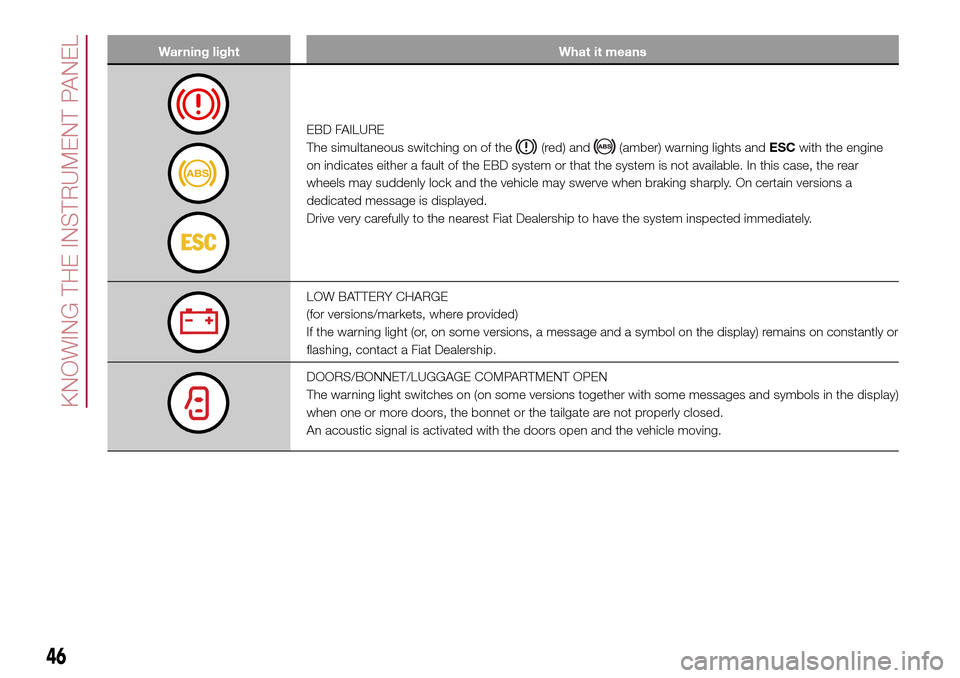
Warning light What it means
EBD FAILURE
The simultaneous switching on of the
(red) and(amber) warning lights andESCwith the engine
on indicates either a fault of the EBD system or that the system is not available. In this case, the rear
wheels may suddenly lock and the vehicle may swerve when braking sharply. On certain versions a
dedicated message is displayed.
Drive very carefully to the nearest Fiat Dealership to have the system inspected immediately.
LOW BATTERY CHARGE
(for versions/markets, where provided)
If the warning light (or, on some versions, a message and a symbol on the display) remains on constantly or
flashing, contact a Fiat Dealership.
DOORS/BONNET/LUGGAGE COMPARTMENT OPEN
The warning light switches on (on some versions together with some messages and symbols in the display)
when one or more doors, the bonnet or the tailgate are not properly closed.
An acoustic signal is activated with the doors open and the vehicle moving.
46
KNOWING THE INSTRUMENT PANEL
Page 73 of 240
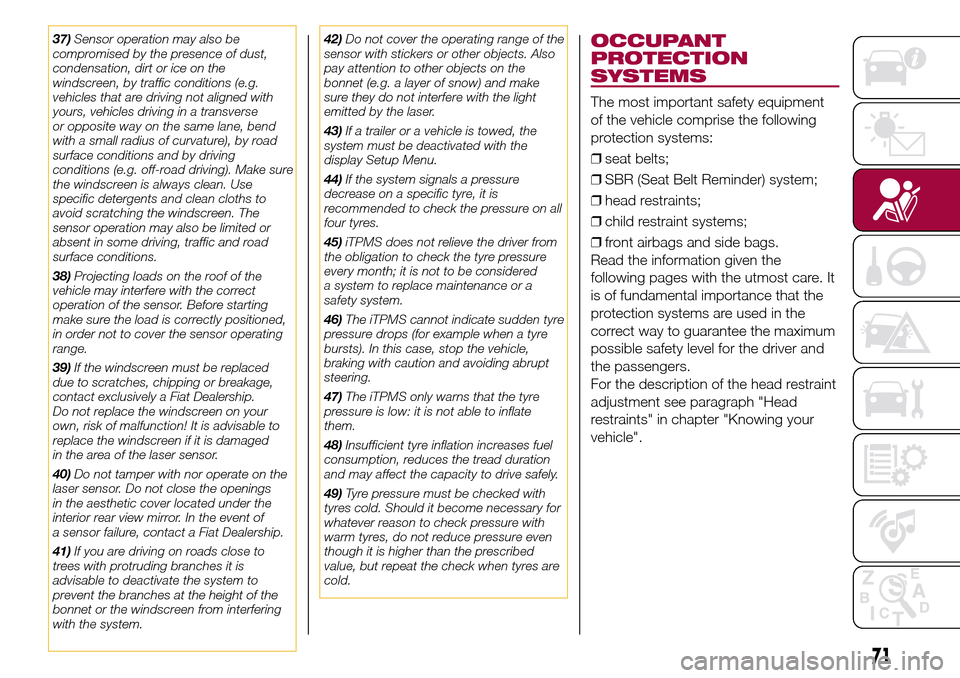
37)Sensor operation may also be
compromised by the presence of dust,
condensation, dirt or ice on the
windscreen, by traffic conditions (e.g.
vehicles that are driving not aligned with
yours, vehicles driving in a transverse
or opposite way on the same lane, bend
with a small radius of curvature), by road
surface conditions and by driving
conditions (e.g. off-road driving). Make sure
the windscreen is always clean. Use
specific detergents and clean cloths to
avoid scratching the windscreen. The
sensor operation may also be limited or
absent in some driving, traffic and road
surface conditions.
38)Projecting loads on the roof of the
vehicle may interfere with the correct
operation of the sensor. Before starting
make sure the load is correctly positioned,
in order not to cover the sensor operating
range.
39)If the windscreen must be replaced
due to scratches, chipping or breakage,
contact exclusively a Fiat Dealership.
Do not replace the windscreen on your
own, risk of malfunction! It is advisable to
replace the windscreen if it is damaged
in the area of the laser sensor.
40)Do not tamper with nor operate on the
laser sensor. Do not close the openings
in the aesthetic cover located under the
interior rear view mirror. In the event of
a sensor failure, contact a Fiat Dealership.
41)If you are driving on roads close to
trees with protruding branches it is
advisable to deactivate the system to
prevent the branches at the height of the
bonnet or the windscreen from interfering
with the system.42)Do not cover the operating range of the
sensor with stickers or other objects. Also
pay attention to other objects on the
bonnet (e.g. a layer of snow) and make
sure they do not interfere with the light
emitted by the laser.
43)If a trailer or a vehicle is towed, the
system must be deactivated with the
display Setup Menu.
44)If the system signals a pressure
decrease on a specific tyre, it is
recommended to check the pressure on all
four tyres.
45)iTPMS does not relieve the driver from
the obligation to check the tyre pressure
every month; it is not to be considered
a system to replace maintenance or a
safety system.
46)The iTPMS cannot indicate sudden tyre
pressure drops (for example when a tyre
bursts). In this case, stop the vehicle,
braking with caution and avoiding abrupt
steering.
47)The iTPMS only warns that the tyre
pressure is low: it is not able to inflate
them.
48)Insufficient tyre inflation increases fuel
consumption, reduces the tread duration
and may affect the capacity to drive safely.
49)Tyre pressure must be checked with
tyres cold. Should it become necessary for
whatever reason to check pressure with
warm tyres, do not reduce pressure even
though it is higher than the prescribed
value, but repeat the check when tyres are
cold.OCCUPANT
PROTECTION
SYSTEMS
The most important safety equipment
of the vehicle comprise the following
protection systems:
❒seat belts;
❒SBR (Seat Belt Reminder) system;
❒head restraints;
❒child restraint systems;
❒front airbags and side bags.
Read the information given the
following pages with the utmost care. It
is of fundamental importance that the
protection systems are used in the
correct way to guarantee the maximum
possible safety level for the driver and
the passengers.
For the description of the head restraint
adjustment see paragraph "Head
restraints" in chapter "Knowing your
vehicle".
71
Page 101 of 240
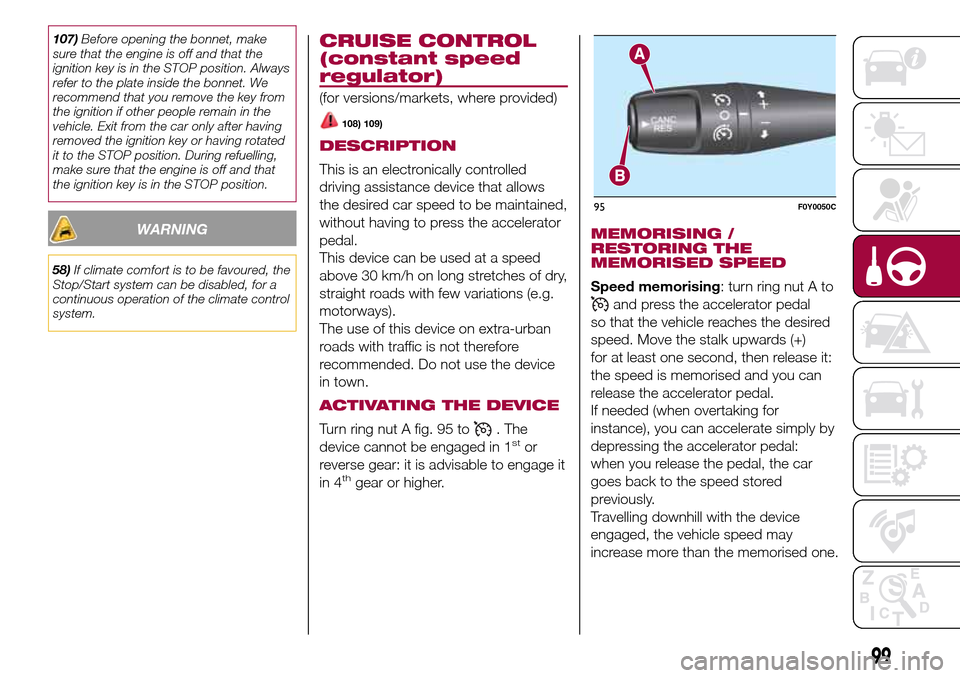
107)Before opening the bonnet, make
sure that the engine is off and that the
ignition key is in the STOP position. Always
refer to the plate inside the bonnet. We
recommend that you remove the key from
the ignition if other people remain in the
vehicle. Exit from the car only after having
removed the ignition key or having rotated
it to the STOP position. During refuelling,
make sure that the engine is off and that
the ignition key is in the STOP position.
WARNING
58)If climate comfort is to be favoured, the
Stop/Start system can be disabled, for a
continuous operation of the climate control
system.
CRUISE CONTROL
(constant speed
regulator)
(for versions/markets, where provided)
108) 109)
DESCRIPTION
This is an electronically controlled
driving assistance device that allows
the desired car speed to be maintained,
without having to press the accelerator
pedal.
This device can be used at a speed
above 30 km/h on long stretches of dry,
straight roads with few variations (e.g.
motorways).
The use of this device on extra-urban
roads with traffic is not therefore
recommended. Do not use the device
in town.
ACTIVATING THE DEVICE
Turn ring nut A fig. 95 to. The
device cannot be engaged in 1stor
reverse gear: it is advisable to engage it
in 4
thgear or higher.
MEMORISING /
RESTORING THE
MEMORISED SPEED
Speed memorising: turn ring nut A to
and press the accelerator pedal
so that the vehicle reaches the desired
speed. Move the stalk upwards (+)
for at least one second, then release it:
the speed is memorised and you can
release the accelerator pedal.
If needed (when overtaking for
instance), you can accelerate simply by
depressing the accelerator pedal:
when you release the pedal, the car
goes back to the speed stored
previously.
Travelling downhill with the device
engaged, the vehicle speed may
increase more than the memorised one.
95F0Y0050C
99
Page 135 of 240
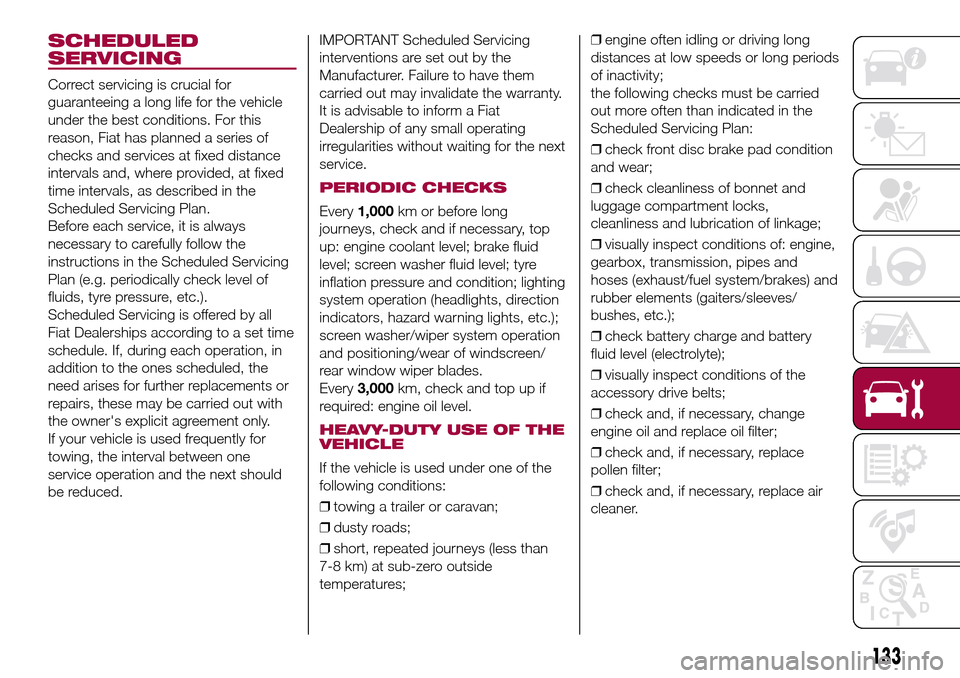
SCHEDULED
SERVICING
Correct servicing is crucial for
guaranteeing a long life for the vehicle
under the best conditions. For this
reason, Fiat has planned a series of
checks and services at fixed distance
intervals and, where provided, at fixed
time intervals, as described in the
Scheduled Servicing Plan.
Before each service, it is always
necessary to carefully follow the
instructions in the Scheduled Servicing
Plan (e.g. periodically check level of
fluids, tyre pressure, etc.).
Scheduled Servicing is offered by all
Fiat Dealerships according to a set time
schedule. If, during each operation, in
addition to the ones scheduled, the
need arises for further replacements or
repairs, these may be carried out with
the owner's explicit agreement only.
If your vehicle is used frequently for
towing, the interval between one
service operation and the next should
be reduced.IMPORTANT Scheduled Servicing
interventions are set out by the
Manufacturer. Failure to have them
carried out may invalidate the warranty.
It is advisable to inform a Fiat
Dealership of any small operating
irregularities without waiting for the next
service.
PERIODIC CHECKS
Every1,000km or before long
journeys, check and if necessary, top
up: engine coolant level; brake fluid
level; screen washer fluid level; tyre
inflation pressure and condition; lighting
system operation (headlights, direction
indicators, hazard warning lights, etc.);
screen washer/wiper system operation
and positioning/wear of windscreen/
rear window wiper blades.
Every3,000km, check and top up if
required: engine oil level.
HEAVY-DUTY USE OF THE
VEHICLE
If the vehicle is used under one of the
following conditions:
❒towing a trailer or caravan;
❒dusty roads;
❒short, repeated journeys (less than
7-8 km) at sub-zero outside
temperatures;❒engine often idling or driving long
distances at low speeds or long periods
of inactivity;
the following checks must be carried
out more often than indicated in the
Scheduled Servicing Plan:
❒check front disc brake pad condition
and wear;
❒check cleanliness of bonnet and
luggage compartment locks,
cleanliness and lubrication of linkage;
❒visually inspect conditions of: engine,
gearbox, transmission, pipes and
hoses (exhaust/fuel system/brakes) and
rubber elements (gaiters/sleeves/
bushes, etc.);
❒check battery charge and battery
fluid level (electrolyte);
❒visually inspect conditions of the
accessory drive belts;
❒check and, if necessary, change
engine oil and replace oil filter;
❒check and, if necessary, replace
pollen filter;
❒check and, if necessary, replace air
cleaner.
133